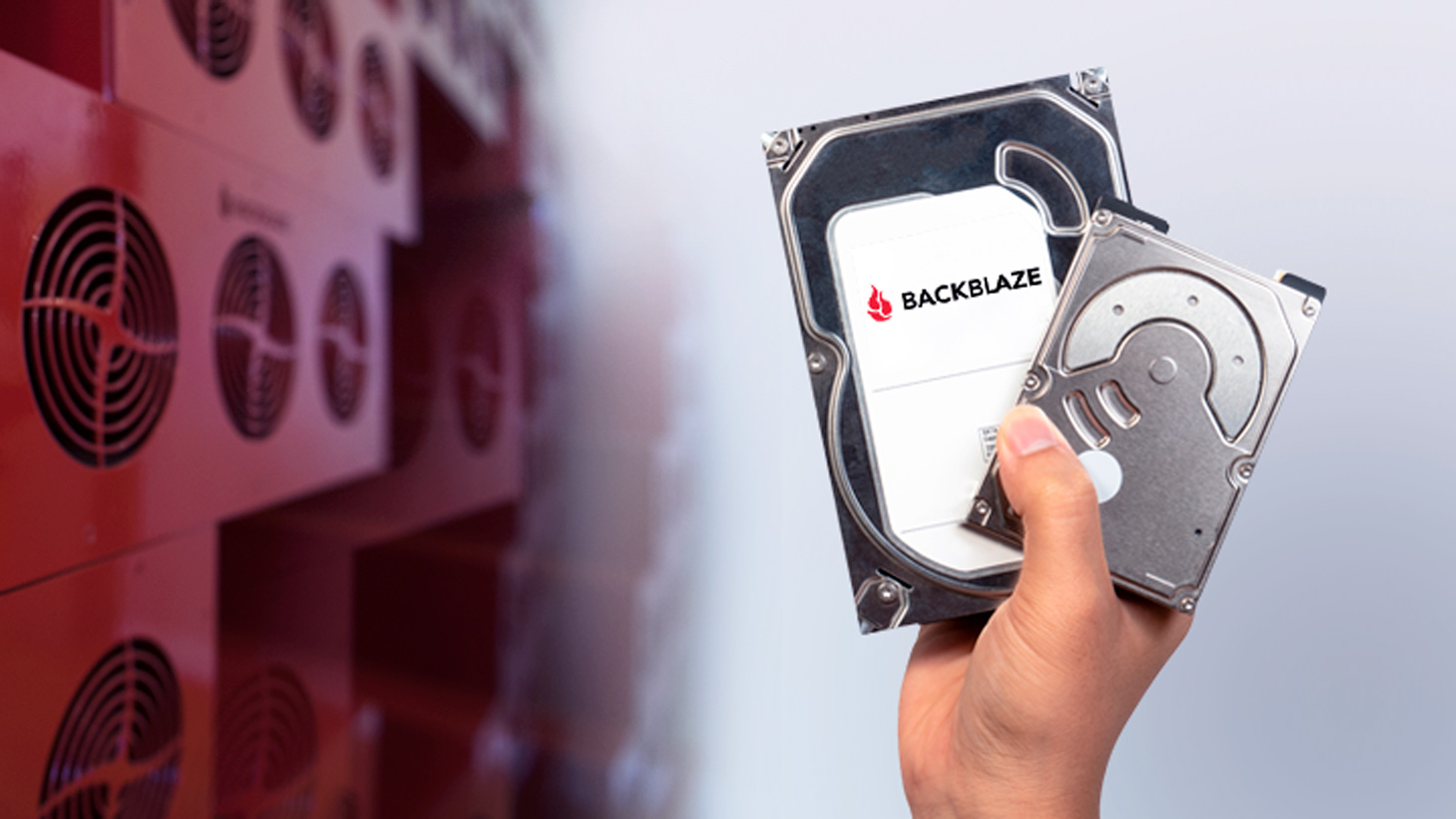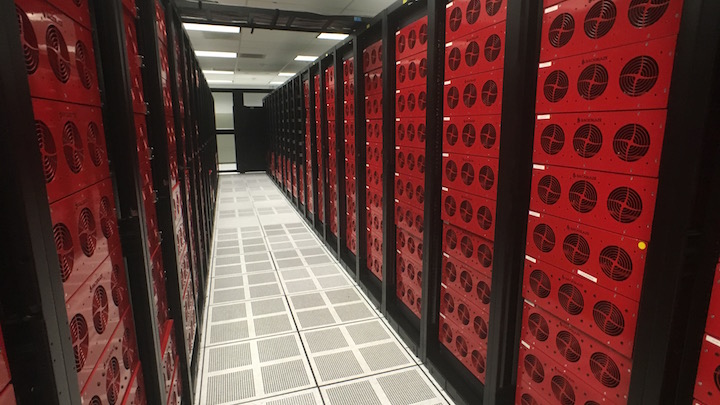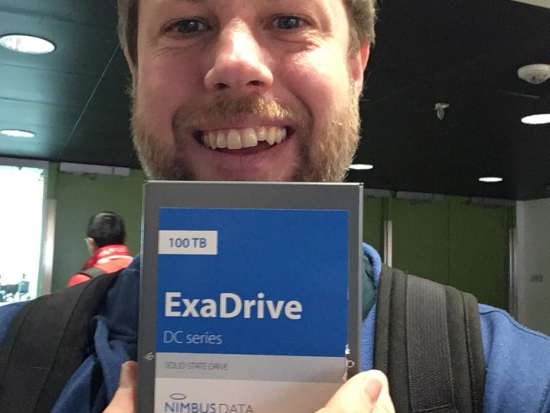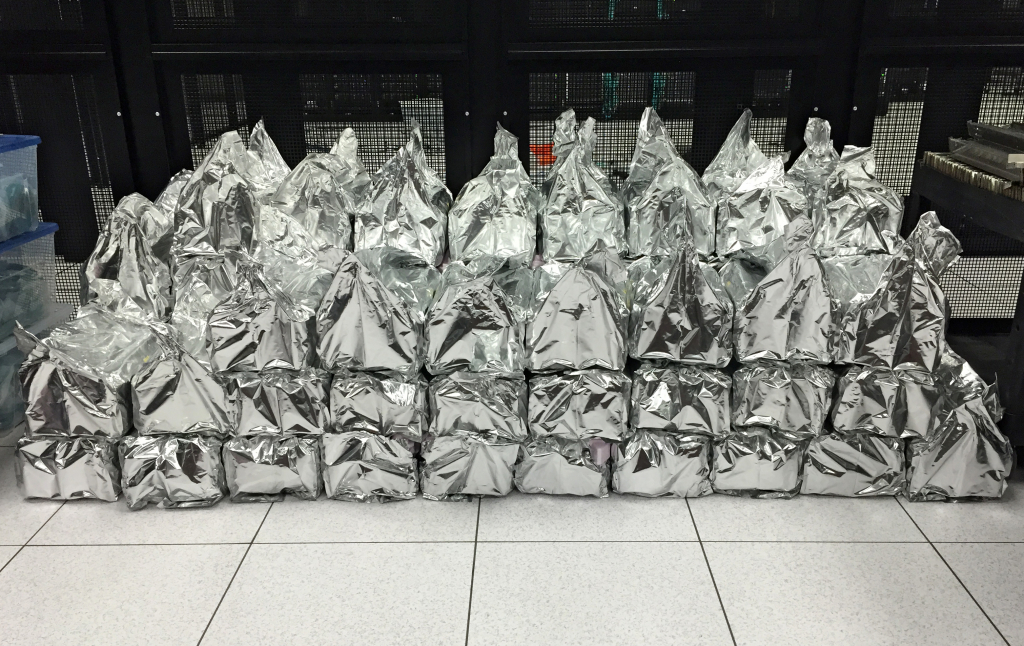
Backblaze’s data centers may not be the biggest in the world of data storage, but thanks to some chutzpah, transparency, and wily employees, we’re able to punch well above our weight when it comes to purchasing hard drives. No one knows this better than our Director of Supply Chain, Ariel Ellis.
As the person on staff ultimately responsible for sourcing the drives our data centers need to run—some 117,658 by his last count—Ariel knows a thing or two about purchasing petabytes-worth of storage. So we asked him to share his insights on the evaluation and purchasing process here at Backblaze. While we’re buying at a slightly larger volume than some of you might be, we hope you find Ariel’s approach useful and that you’ll share your own drive purchasing philosophies in the comments below.
An Interview with Ariel Ellis, Director of Supply Chain at Backblaze
Sourcing and Purchasing Drives
Backblaze: Thanks for making time, Ariel—we know staying ahead of the burn rate always keeps you busy. Let’s start with the basics: What kinds of hard drives do we use in our data centers, and where do we buy them?
Ariel: In the past, we purchased both consumer and enterprise hard drives. We bought the drives that gave us the best performance and longevity for the price, and we discovered that, in many cases, those were consumer drives.
Today, our purchasing volume is large enough that consumer drives are no longer an option. We simply can’t get enough. High capacity drives in high volume are only available to us in enterprise models. But, by sourcing large volume and negotiating prices directly with each manufacturer, we are able to achieve lower costs and better performance than we could when we were only buying in the consumer channel. Additionally, buying directly gives us five year warranties on the drives, which is essential for our use case.
We began to purchase direct around the launch of our Vault architecture, in 2015. Each Vault contains 1,200 drives and we have been deploying two to four, or more, Vaults each month. 4,800 drives are just not available through consumer distribution. So we now purchase drives from all three hard drive manufacturers: Western Digital, Toshiba, and Seagate.
Backblaze: Of the drives we’re purchasing, are they all 7200 RPM and 3.5” form factor? Is there any reason we’d consider slower drives or 2.5” drives?
Ariel: We use drives with varying speeds, though some power-conserving drives don’t disclose their drive speed. Power draw is a very important metric for us and the high speed enterprise drives are expensive in terms of power cost. We now total around 1.5 megawatts in power consumption in our centers, and I can tell you that every watt matters for reducing costs.
As far as 2.5″ drives, I’ve run the math and they’re not more cost effective than 3.5″ drives, so there’s no incentive for us to use them.
Backblaze: What about other drive types and modifications, like SSD, or helium enclosures, or SMR drives? What are we using and what have we tried beyond the old standards?
Ariel: When I started at Backblaze, SSDs were more than ten times the cost of conventional hard drives. Now they’re about three times the cost. But for Backblaze’s business, three times the cost is not viable for the pricing targets we have to meet. We do use some SSDs as boot drives, as well as in our backend systems, where they are used to speed up caching and boot times, but there are currently no flash drives in our Storage Pods—not in HDD or M.2 formats. We’ve looked at flash as a way to manage higher densities of drives in the future and we’ll continue to evaluate their usefulness to us.
Helium has its benefits, primarily lower power draw, but it makes drive service difficult when that’s necessary. That said, all the drives we have purchased that are larger than 8 TB have been helium—they’re just part of the picture for us. Higher capacity drives, sealed helium drives, and other new technologies that increase the density of the drives are essential to work with as we grow our data centers, but they also increase drive fragility, which is something we have to manage.
SMR would give us a 10-15% capacity-to-dollar boost, but it also requires host-level management of sequential data writing. Additionally, the new archive type of drives require a flash-based caching layer. Both of these requirements would mean significant increases in engineering resources to support and thereby even more investment. So all-in-all, SMR isn’t cost-effective in our system.
Soon we’ll be dealing with MAMR and HAMR drives as well. We plan to test both technologies in 2020. We’re also testing interesting new tech like Seagate’s MACH.2 Multi Actuator, which allows the host to request and receive data simultaneously from two areas of the drive in parallel, potentially doubling the input/output operations per second (IOPS) performance of each individual hard drive. This offsets issues of reduced data availability that would otherwise arise with higher drive capacities. The drive also can present itself as two independent drives. For example, a 16 TB drive can appear as two independent 8 TB drives. A Vault using 60 drives per pod could present as 120 drives per pod. That offers some interesting possibilities.
Backblaze: What does it take to deploy a full vault, financially speaking? Can you share the cost?
Ariel: The cost to deploy a single vault varies between $350,000 to $500,000, depending on the drive capacities being used. This is just the purchase price though. There is also the cost of data center space, power to house and run the hardware, the staff time to install everything, and the bandwidth used to fill it. All of that should be included in the total cost of filling a vault.

Evaluating and Testing New Drive Models
Backblaze: Okay, so when you get to the point where the tech seems like it will work in the data center, how do you evaluate new drive models to include in the Vaults?
Ariel: First, we select drives that fit our cost targets. These are usually high capacity drives being produced in large volumes for the cloud market. We always start with test batches that are separate from our production data storage. We don’t put customers’ data on the test drives. We evaluate read/write performance, power draw, and generally try to understand how the drives will behave in our application. Once we are comfortable with the drive’s performance, we start adding small amounts to production vaults, spread across tomes in a way that does not sacrifice parity. As drive capacities increase, we are putting more and more effort into this qualification process.
We used to be able to qualify new drive models in thirty days. Now we typically take several months. On one hand, this is because we’ve added more steps to pre- and post-production testing. As we scale up, we need to scale up our care, because the effect of any issues with drives increases in line with bigger and bigger implementations. Additionally, from a simple physics perspective, a vault that uses high capacity drives takes longer to fill and we want to monitor the new drive’s performance throughout the entire fill period.
Backblaze: When it comes to the evaluation of the cost, is there a formula for $/terabyte that you follow?
Ariel: My goal is to reduce cost per terabyte on a quarterly basis—in fact, it’s a part of how my job performance is evaluated. Ideally, I can achieve a 5-10% cost reduction per terabyte per quarter, which is a number based on historical price trends and our performance for the past 10 years. That savings is achieved in three primary ways: 1) lowering the actual cost of drives by negotiating with vendors, 2) occasionally moving to higher drive densities, and 3) increasing the slot density of pod chassis. (We moved from 45 drives to 60 drives in 2016, and as we look toward our next Storage Pod version we’ll consider adding more slots per chassis).

Meeting Storage Demand
Backblaze: When it comes to how this actually works in our operating environment, how do you stay ahead of the demand for storage capacity?
Ariel: We maintain several months of the drive space that we would need to meet capacity based on predicted demand from current customers as well as projected new customers. Those buffers are tied to what we expect will be the fill-time of our Vaults. As conditions change, we could decide to extend those buffers. Demand could increase unexpectedly, of course, so our goal is to reduce the fill-time for Vaults so we can bring more storage online as quickly as possible, if it’s needed.
Backblaze: Obviously we don’t operate in a vacuum, so do you worry about how trade challenges, weather, and other factors might affect your ability to obtain drives?
Ariel: (Laughs) Sure, I’ve got plenty to worry about. But we’ve proved to be pretty resourceful in the past when we’re challenged. For example: During the worldwide drive shortage, due to flooding in Southeast Asia, we recruited an army of family and friends to buy drives all over and send them to us. That kept us going during the shortage.
We are vulnerable, of course, if there’s a drive production shortage. Some data center hardware is manufactured in China, and I know that some of those prices have gone up. That said, all of our drives are manufactured in Thailand or Taiwan. Our Storage Pod chassis are made in the U.S.A. Big picture, we try to anticipate any shortages and plan accordingly if we can.

Data Durability
Backblaze: Time for a personal question… What does data durability mean to you? What do you do to help boost data durability, and spread drive hardware risk and exposure?
Ariel: That is personal. (Laughs). But also a good question, and not really personal at all: Everyone at Backblaze contributes to our data durability in different ways.
My role in maintaining eleven nines of durability is, first and foremost: Never running out of space. I achieve this by maintaining close relationships with manufacturers to ensure production supply isn’t interrupted; by improving our testing and qualification processes to catch problems before drives ever enter production; and finally by monitoring performance and replacing drives before they fail. Otherwise it’s just monitoring the company’s burn rates and managing the buffer between our drive capacity and our data under management.
When we are in a good state for space considerations, then I need to look to the future to ensure I’m providing for more long-term issues. This is where iterating on and improving our Storage Pod design comes in. I don’t think that gets factored into our durability calculus, but designing for the future is as important as anything else. We need to be prepared with hardware that can support ever-increasing hard drive capacities—and the fill- and rebuild times that come with those increases—effectively.
Backblaze: That begs the next question: As drive sizes get larger, rebuild times get longer when it’s necessary to recover data on a drive. Is that still a factor, given Backblaze’s durability architecture?
Ariel: We attempt to identify and replace problematic drives before they actually fail. When a drive starts failing, or is identified for replacement, the team always attempts to restore as much data as possible off of it because that ensures we have the most options for maintaining data durability. The rebuild times for larger drives are challenging, especially as we move to 16TB and beyond. We are looking to improve the throughput of our Pods before making the move to 20TB in order to maintain fast enough rebuild times.
And then, supporting all of this is our Vault architecture, which ensures that data will be intact even if individual drives fail. That’s the value of the architecture.
Longer term, one thing we’re looking toward is phasing out SATA controller/port multiplier combo. This might be more technical than some of our readers want to go, but: SAS controllers are a more commonly used method in dense storage servers. Using SATA drives with SAS controllers can provide as much as a 2x improvement in system throughput vs SATA, which is important to me, even though serial ATA (SATA) port multipliers are slightly less expensive. When we started our Storage Pod construction, using SATA controller/port multiplier combo was a great way to keep costs down. But since then, the cost for using SAS controllers and backplanes has come down significantly.
But now we’re preparing for how we’ll handle 18 and 20 TB drives, and improving system throughput will be extremely important to manage that density. We may even consider using SAS drives even though they are slightly more expensive. We need to consider all options in order to meet our scaling, durability and cost targets.

Backblaze’s Relationship with Drive Manufacturers
Backblaze: So, there’s an elephant in the room when it comes to Backblaze and hard drives: Our quarterly Hard Drive Stats reports. We’re the only company sharing that kind of data openly. How have the Drive Stats blog posts affected your purchasing relationship with the drive manufacturers?
Ariel: Due to the quantities we need and the visibility of the posts, drive manufacturers are motivated to give us their best possible product. We have a great purchasing relationship with all three companies and they update us on their plans and new drive models coming down the road.
Backblaze: Do you have any sense for what the hard drive manufacturers think of our Drive Stats blog posts?
Ariel: I know that every drive manufacturer reads our Drive Stats reports, including very senior management. I’ve heard stories of company management learning of the release of a new Drive Stats post and gathering together in a conference room to read it. I think that’s great.
Ultimately, we believe that Drive Stats is good for consumers. We wish more companies with large data centers did this. We believe it helps keep everyone open and honest. The adage is that competition is ultimately good for everyone, right?
It’s true that Western Digital, at one time, was put off by the visibility Drive Stats gave into how their models performed in our data centers (which we’ve always said is a lot different from how drives are used in homes and most businesses). Then they realized the marketing value for them—they get a lot of exposure in the blog posts—and they came around.
Backblaze: So, do you believe that the Drive Stats posts give Backblaze more influence with drive manufacturers?
Ariel: The truth is that most hard drives go directly into tier-one and -two data centers, and not into smaller data centers, homes, or businesses. The manufacturers are stamping out drives in exabyte chunks. A single tier-one data center consumes maybe 500,000 times what Backblaze does in drives. We can’t compare in purchasing power to those guys, but Drive Stats does give us visibility and some influence with the manufacturers. We have close communications with the manufacturers and we get early versions of new drives to evaluate and test. We’re on their radar and I believe they value their relationship with us, as we do with them.
Backblaze: A final question. In your opinion, are hard drives getting better?
Ariel: Yes. Drives are amazingly durable for how hard they’re used. Just think of the forces inside a hard drive, how hard they spin, and how much engineering it takes to write and read the data on the platters. I came from a background in precision optics, which requires incredibly precise tolerances, and was shocked to learn that hard drives are designed in an equally precise tolerance range, yet are made in the millions and sold as a commodity. Despite all that, they have only about a 2% annual failure rate in our centers. That’s pretty good, I think.
Thanks, Ariel. Here’s hoping the way we source petabytes of storage has been useful for your own terabyte, petabyte, or… exabyte storage needs? If you’re working on the latter, or anything between, we’d love to hear about what you’re up to in the comments.













 Wanted: Director of Marketing Operations
Wanted: Director of Marketing Operations